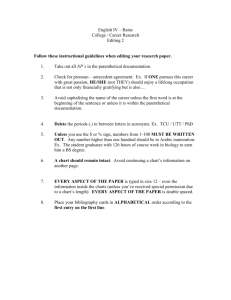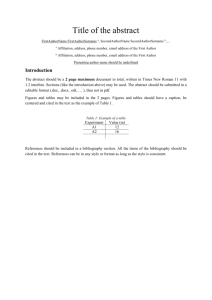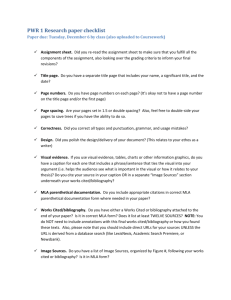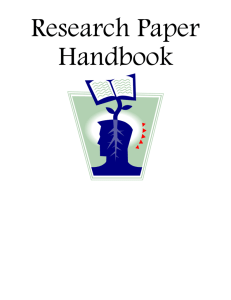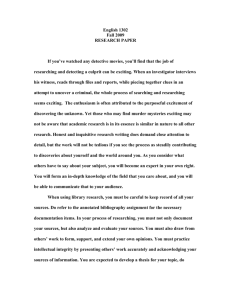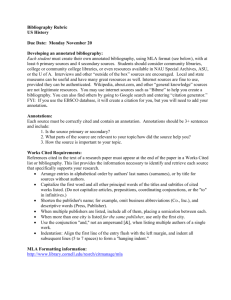Research Paper Requirements
advertisement
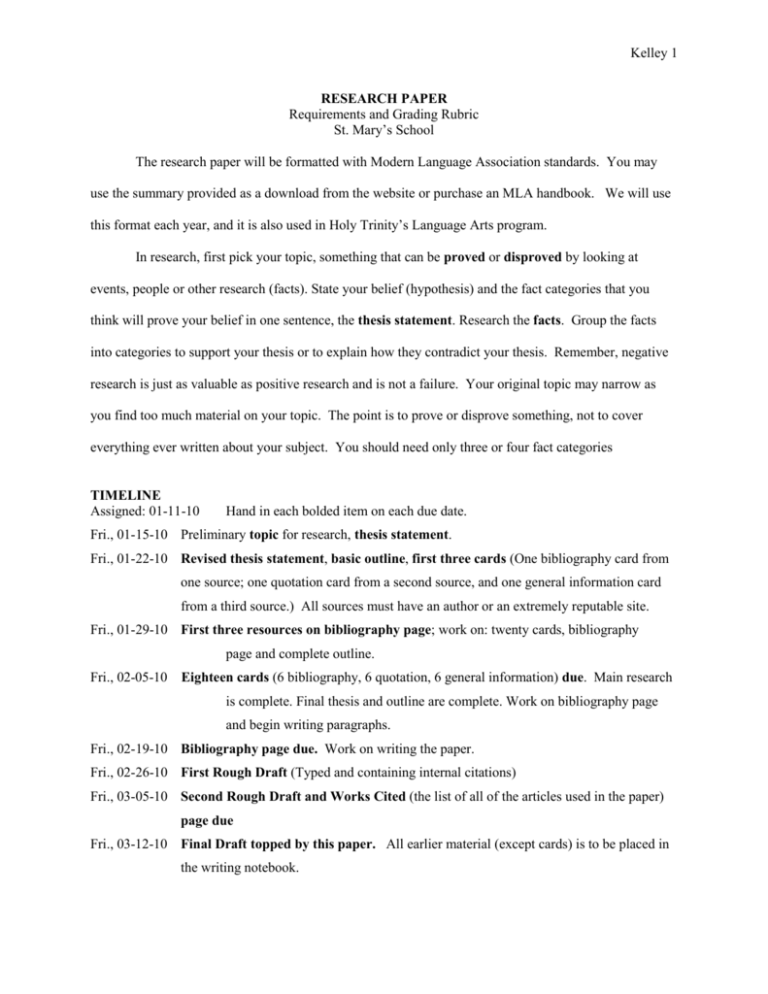
Kelley 1 RESEARCH PAPER Requirements and Grading Rubric St. Mary’s School The research paper will be formatted with Modern Language Association standards. You may use the summary provided as a download from the website or purchase an MLA handbook. We will use this format each year, and it is also used in Holy Trinity’s Language Arts program. In research, first pick your topic, something that can be proved or disproved by looking at events, people or other research (facts). State your belief (hypothesis) and the fact categories that you think will prove your belief in one sentence, the thesis statement. Research the facts. Group the facts into categories to support your thesis or to explain how they contradict your thesis. Remember, negative research is just as valuable as positive research and is not a failure. Your original topic may narrow as you find too much material on your topic. The point is to prove or disprove something, not to cover everything ever written about your subject. You should need only three or four fact categories TIMELINE Assigned: 01-11-10 Hand in each bolded item on each due date. Fri., 01-15-10 Preliminary topic for research, thesis statement. Fri., 01-22-10 Revised thesis statement, basic outline, first three cards (One bibliography card from one source; one quotation card from a second source, and one general information card from a third source.) All sources must have an author or an extremely reputable site. Fri., 01-29-10 First three resources on bibliography page; work on: twenty cards, bibliography page and complete outline. Fri., 02-05-10 Eighteen cards (6 bibliography, 6 quotation, 6 general information) due. Main research is complete. Final thesis and outline are complete. Work on bibliography page and begin writing paragraphs. Fri., 02-19-10 Bibliography page due. Work on writing the paper. Fri., 02-26-10 First Rough Draft (Typed and containing internal citations) Fri., 03-05-10 Second Rough Draft and Works Cited (the list of all of the articles used in the paper) page due Fri., 03-12-10 Final Draft topped by this paper. All earlier material (except cards) is to be placed in the writing notebook. Kelley 2 REQUIREMENTS/GRADING POINTS MLA Format: Cards: _____/150 Twenty+: Bibliographic (6) Quotation (6) General information (8) Minimum six sources _____ _____ _____ _____ _____ Paper: Margins (1”) 12 point Times New Roman Double Spaced Correct first page Running header Internal Citations Works Cited Page: (only cited works) Bibliography: (all sources including cited) Outline Contents: Introduction Attention Getter Thesis Body: Proof Point one Proof Point two Proof Point three Conclusion: Summary Review of Thesis Reference to Attention Getter Mechanics (-1 point for each error in the following): Complete sentences Paragraphs Correct Spelling Correct Punctuation _____ _____ _____ _____ _____ _____ _____ _____ _____ _____/80 _____ _____ _____ _____ _____ _____ _____ _____ _____/100 Following Directions: Met Meeting deadlines: _____ _____ _____ _____ _____ _____ _____ _____ _____ Maximum five pages plus Works Cited and Bibliography _____/200 In _____ _____ _____ _____ _____ _____ _____ _____ _____ Kelley 3 Research Paper Requirements Research Note Cards You must have a minimum of 18 research note cards. The following format is to be used. Bibliographic Note Cards: For each new source, create a separate note card that includes all relevant bibliographic information (all titles, authors, publisher, page numbers, dates, etc. needed for the Works Cited page). Keep in mind the different information required for various kinds of sources! Number each source card in the upper, right-hand corner. For any quotation or general information taken from that particular source, write the corresponding source number on the note card’s upper, right-hand corner. 1B Silver, Lee M. Remaking Eden: Cloning and Beyond in a Brave New World. New York: Avon, 1997. Print. ----- Number identifying source, and letter identifying type of card (B= Bibliography, Q=quotation, G=general information) (Format for a printed book.) Quotation Cards: Put one quotation per note card. Indicate the number of the source in the upper, right-hand corner of the card. DO NOT REWRITE SOURCE INFORMATION ANYWHERE ON THE NOTECARD. Be sure to include quotation marks if you are using a phrase or passage word-for-word. When writing your paper, you may choose to paraphrase that quotation, but you will still need to internally document that source! Include the page number on which you found the quotation. 4Q “President Bush has agreed to federal emergency support funding 95% of the Hurricane Katrina victims.” (page 37) General Information Cards: Include facts, statistics, opinions from the article. Indicate the number of the source in the upper, right-hand corner of the card. DO NOT REWRITE SOURCE INFORMATION ANYWHERE ON THE NOTECARD 3G Seventy of one hundred smokers will contract some form of cancer in their lifetimes. Kelley 4 MLA Format In most English and soft science classes, you will be asked to use MLA (Modern Language Association) guidelines for formatting a paper and preparing a list of the works you have cited. The following guidelines are taken from the MLA Handbook for Writers of Research Papers, 7th ed. (New York: MLA, 2009). MATERIALS Use good-quality 8½" x 11" white paper. TITLE AND IDENTIFICATION MLA does not require a title page. On the first page of your paper, place your name, your instructor's name, the course title, and the date on separate lines against the left margin. Then center your title. PAGINATION Put the page number preceded by your last name in the upper right corner of each page, one-half inch below the top edge. Use arabic numerals (1, 2, 3, and so on). MARGINS, LINE SPACINGS, PARAGRAPH INDENTS Leave margins of one inch on all sides of the page. Do not justify (align) the right margin. Double-space throughout the paper. Do not add extra lines of space above or below the title of the paper or between paragraphs. Indent the first line of each paragraph one-half inch (or five spaces) from the left margin. Basic MLA Internal Documentation 1. Match your parenthetical reference to the first word(s) of the Works Cited entry. That way, someone reading your paper can go to your source for more information. 2. For a book, the parenthetical reference in your paragraph will normally include the author’s last name and the page on which you found the information. Ancient writers attributed the invention of the monochord to Pythagoras (Marcuse 197). According to Marcuse, ancient writers attributed the invention of the monochord to Pythagoras (197). –Note: the author is identified within the body of the sentence. Matching Works Cited entry: Marcuse, Sibyl. A Survey of Musical Instruments. New York: Harper, 1975. 3. If a source has no author, use what comes first in the Works Cited entry. International espionage was as prevalent as ever in the 1990s (“Decade” 26). Matching Works Cited entry: “Decade of the Spy.” Newsweek. 7 Mar. 1994: 26-27. 4. Electronic sources: When Julius Caesar debuted at the Globe Theater, it became a place of “courage and ideas, a place where an audience must observe with the inner eye, listen with the inner ear” (Sohmer par. 44). Kelley 5 Matching Works Cited entry: Sohmer, Steve. “12 June 1599: Opening Day at Shakespeare’s Globe.” Early Modern Literary Studies 3.1 (1997): 46 pars. Web. 22 June 1998. 5. The parenthetical reference precedes the punctuation mark that concludes the sentence, clause or phrase containing the borrowed material. Others, like Jakobson and Waugh (210-15), hold the opposite point of view. 6. Be sure to put in quotation marks around any words quoted verbatim. 7. Be sure to cite any paraphrased information—including facts and statistics—that is not considered general knowledge. OTHERWISE IT IS CALLED PLAGIARISM. See MLA Handbook for more specific information on sources not covered here. MLA Works Cited/Bibliography Information A bibliography is a list of all sources you used in compiling a document. You should arrange the bibliography in alphabetical order by the author’s last name or, if there is no author, by the first main word of the title. You can ignore A, And, and The in a title. There are several bibliographic styles, and depending on your research topic, one may be more appropriate than others. Be sure to find out what style you should use for your topic. Don’t mix styles because you may confuse your reader. The examples in this bibliography are written in the Modern Language Association (MLA) style. The rules for an MLA bibliography style are: Double-space all entries. Use hanging indent paragraph styles (the first line of the paragraph is aligned with the left margin, and all subsequent lines are indented .5 inches from the left margin) Type authors’ last names first, with the last and first names separated by a comma, unless there are two or more authors. For references that have multiple authors, type the last name first for the first author, and type subsequent names with the first name first. Type titles’ full names and begin each important word with a capital letter. Use italics or underlines for the titles of books and periodicals. Enclose titles of periodical articles in quotation marks. Type any publication information (place of publication, publisher’s name, year, and so on) after each reference title. Separate each portion of each bibliography entry with a period followed by two spaces. Sample MLA Works Cited/Bibliography Entries Kelley 6 One Author: Book Silver, Lee M. Remaking Eden: Cloning and Beyond in a Brave New World. New York: Avon, 1997. Print. Two or Three Authors: Book Bystydzienski, Jill M., and Estelle P. Resnik. Women in Cross-Cultural Transitions. Bloomington, IN: Phi Delta Kappa Educational Foundation, 1994. Print. More than Three Authors: Book Marine, April, et al. Internet: Getting Started. Englewood Cliffs, NJ: PTR Prentice Hall, 1994. Print A Single Work from an Anthology (Collection of Works) Rich, Adrienne. “Re-Forming the Crystal.” Contemporary American Poetry. Ed. A. Poulin, Jr. 3rd ed. Boston: Houghton Mifflin Company, 1980. 396. Print. An Anonymous Book The World Almanac Book of the Strange. New York: New American Library, 1977. Print. A Multi-volume Book Ziegler, Alan. The Writing Workshop. Vol. 2. New York: Teachers and Writers, 1984. Print An Introduction, Preface, Foreword, or Afterword Callan, Edward. Introduction. Cry, the Beloved Country. By Alan Paton. New York: Macmillan, 1987. xv-xvii. Print Newspaper Articles Lohr, Steve. “Now Playing: Babes in Cyberspace.” New York Times. 3 Apr. 1998, late ed.: C1+. Print Kelley 7 Magazine Articles Bazell, Robert. “Science and Society: Growth Industry.” New Republic. 15 Mar. 1993: 13-14. Print. Online Markoff, John. “The Voice on the Phone is not Human, but It’s Helpful.” New YorkTimes on the Web. New York Times. 21 June 2008. Web. 15 June 2009. Wang, Shan. “So You Want to Be a Writer.” The Atlantic.com. Atlantic Monthly Group, Aug. 2006. Web. 15 June 2009. (Template: Last Name, First Middle. “Title of Article or Piece.” Title of Website. Edition or Version. Site sponsor or Publisher, Day Month (Abbreviated) Year of publication. Publication medium.. Day Month (Abbr.) Year Accessed. Kelley 8 Sample MLA Paper Daly 1 Angela Daly Ms. Duncan English 4 9 January 2005 Title is centered A Call to Action: Regulate Use of Cell Phones on the Road Hook to catch reader’s attention When a cell phone goes off in a classroom or at a concert, we are irritated, but at least our lives are not endangered. When we are on the road, however, irresponsible cell phone users are more than irritating: They are putting our lives at risk. Many of us have witnessed drivers so distracted by dialing and chatting that they resemble drunk drivers, weaving between lanes, for example, or nearly running down pedestrians in crosswalks. A number of bills to regulate use of cell phones on the road have been introduced in state legislatures, and the time has come to push for their passage. Regulation is needed because drivers using phones are seriously impaired and because laws on negligent and reckless driving are not sufficient to punish offenders. Thesis answers research question No one can deny that cell phones have caused traffic deaths and injuries. Cell phones Use a clear topic were implicated in three fatal accidents in November 1999 alone. Early in November, a sentence driver distracted by his cell phone killed two-year-old Morgan Pena. Morgan’s mother, Patti Pena, reports that the driver “ran a stop sign at 45 mph, broad sided my vehicle and killed Morgan as she sat in her car seat.” A week later, Signal phrase names the author of the quotation to follow. No page number is available for this Web source. Kelley 9 Author’s name given in parentheses; no page # is available Daly 2 corrections officer Shannon Smith, who was guarding prisoners by the side of the road, was killed by a woman distracted by a phone call (Besthoff). On Thanksgiving weekend that same month, John and Carole Hall were killed when a Naval Academy midshipman crashed into their parked car. The driver said in court that when he looked up from the cell phone he was dialing, he was three feet from the car and had no time to stop (Stockwell B8). Page number given when available Use clear topic sentences throughout the paper. Expert testimony, public opinion, and even cartoons suggest that driving while phoning is dangerous. Frances Bents, an expert on the relation between cell phones and accidents, estimates that between 450 and 1,000 crashes a year have some connection to cell phone use (Layton C9). In a survey published by Farmers Insurance Group, 87% of those polled said that cell phones affect a driver’s ability, and 40% reported having close calls with drivers distracted by phones (C11). Scientific research confirms the dangers of using phones while on the road. In 1997 an important study appeared in the New England Journal of Medicine. The authors, Donald Redelmeier and Robert Tibshirani, studied 699 volunteers who made their cell phone bills available in order to confirm the times when they had placed calls. The participants agreed to report any nonfatal collision in which they were involved. By comparing the time of a collision with the phone records, the researchers assessed the dangers of driving while phoning. Here are their results: Long quotation is set off from text; quotation marks are omitted We found that using a cellular telephone was associated with a risk of having a motor vehicle collision that was about four times as high as that among the same drivers when they were not using their cellular telephones. (456) Summary & long quotation are introduced with a signal phrase naming the authors Kelley 10 Works Cited Heading is centered Besthoff, Len. “Cell Phone Use Increases Risk of Accidents, but Users Willing to Take the Risk.” WRAL Online. 11 Nov. 1999. Web. 12 Jan. 2001. Farmers Insurance Group. “New Survey Shows Drivers Have Had ‘Close Calls’ with Cell Phone Users.” Farmers Insurance Group. 8 May 2000. Web. 12 Jan. 2001 Layton, Lyndsey. “Legislators Aiming to Disconnect Motorists.” Washington Post. 10 Dec. 2000: C1+. Print. Pena, Patricia N. “Patti Pena’s Letter to Car Talk.” Cars.com. Car Talk. Web. 10 Jan. 2001. Redelmeier, Donald A., and Robert J. Tibshirani. “Association between Cellular Telephone Calls and Motor Vehicle Collisions.” New England Journal of Medicine 336 (1997): 453-58. Print. Stockwell, Jamie. “Phone Use Faulted in Collision.” Washington Post 6 Dec. 2000: B1+. Print List is alphabetized by first word of entry First line of each entry is at the left margin; extra lines are indented 5 spaces (one tab in) Double spacing is used throughout. No numbers are used at beginning of entries The Modern Language Association of America. MLA Handbook for Writers of Research Papers: Seventh Edition. New York: The Modern Language Association of America, 2009. Print.

